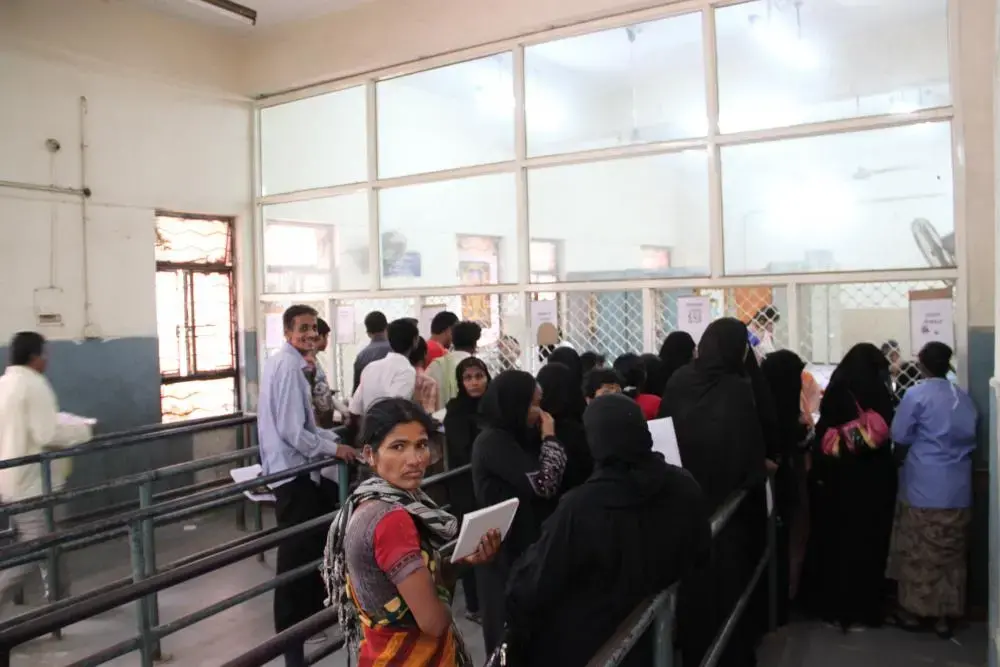On February 21, during the afternoon rush hour in a busy shopping center in downtown Hyderabad in the southern state of Andhra Pradesh, two makeshift bombs packed with bolts and nails were detonated in one of the deadliest terrorist attacks in the city's history. Over 100 people were injured by the blasts, and many were transported for treatment to Osmania General Hospital, the largest public hospital in the city.
In the hours after they arrived at the hospital around 25 of these patients, some of whom were in critical condition, were transferred to a nearby private hospital. When asked to explain this risky patient transfer, the Osmania doctors pointed to broken equipment and a shortage of necessary drugs.
"The wards were in deplorable condition" and the hospital simply couldn't handle the number of patients, said a report sent in March to the state's chief minister, Nallari Kiran Kumar Reddy, by the Alumni Association of Osmania Medical College.
Osmania Hospital was not an isolated case, but part of a long-term trend of neglect in the state's public health care sector. The usual suspects blamed for the hospital's failure included corruption in the Andhra Pradesh Medical Services and Infrastructure Development Corporation (A.P.M.S.I.D.C), the state government's equipment procurement agency, and lack of funding. Some Osmania doctors, however, say that Andhra Pradesh's popular health insurance program, Aarogyasri, also played a part.
Aarogyasri, founded in 2007 by then-Chief Minister Y.S. Rajasekhara Reddy, is the first program in India to provide government-subsidized health insurance to poor families in India. It covers all families with a yearly income of less than 60,000 rupees ($1,000), meaning that almost 85 percent of the state's population qualifies. N Purendra Prasad, a sociologist at the University of Hyderabad, and his co-author, P Raghavendra, argued in an essay in the Economic and Political Weekly, that it was the decisive factor in the Congress Party's victory in the 2009 state elections for the Legislative Assembly.
"The Aarogyasri Trust has empanelled 491 hospitals in the state, of which nearly 80 per cent are in the private sector while the remaining 20 per cent are government hospitals," wrote Mr. Prasad and Mr. Raghavendra. The sociologists also pointed out that although the Aarogyasri scheme was targeted at poor villagers, most of the empanelled hospitals are private hospitals, which don't exist in rural areas.
More questions are being raised about Aarogyasri's impact on health care availability for the poor. A 2011 study by three Harvard School of Public Health fellows said that Aarogyasri only weakens government hospitals by forcing them to compete with private hospitals for patients in order to receive funding. Roughly 13 billion rupees of the state's 60 billion rupee budget for health care goes to Aarogyasri – government funds that used to be spent on equipment in government hospitals are now spent paying private hospitals to treat poor patients.
Dr. Gopal Kishan, the former superintendent of Osmania General Hospital and now a nephrologist at Mediciti Hospital, argues that Aarogyasri has given private hospitals access to government funds that used to pay for the maintenance and staff of public hospitals, leaving public hospitals to lag further behind. "If the government hospitals are improved, they can take the patient load of the entire state," he said.
Instead of improving the public hospitals, however, the government is sending patients to the private sector, he said. "It's a waste," he continued, speaking of the growing number of expensive cochlear implant surgeries at Apollo, many of which were paid for by Aarogyasri.
Private hospitals treat 75 percent of Aarogyasri patients, who avoid public hospitals because of their reputation for inefficiency, overcrowding and lack of basic sanitation. Private hospitals also benefit from their effective advertising campaigns, an expenditure that government hospitals cannot afford. "We are immersed in our work," said C.G. Raghuram, head of the department of anesthesia at Osmania. "We don't have a P.R. representative who projects our achievements."
This bias toward the private sector would not be a problem if patients enrolled in Aarogyasri could go to private hospitals for all of their health care needs. Aarogyasri, however, provides coverage only for illnesses requiring major surgical procedures, which make up roughly two percent of the disease burden in India.
The many patients who do not qualify for coverage face a dilemma: pay out of pocket for care at a private hospital, or go to an understaffed, underfunded government hospital.
For Krishna Laxmi, who works as a farm laborer in the village of Kandur, the lack of funding at government hospitals and her misplaced trust in Aarogyasri coverage had tragic consequences. When severe joint pain began to interfere with her work last year, she went to a local clinic for help. The clinic referred her to Sunshine Hospital, one of the largest private hospitals in Hyderabad, assuring her that Aarogyasri would provide coverage.
At Sunshine, she received CT scans and X-rays costing the equivalent of $1,000, more than a year's wages. She was told that at the hospital that after she paid for the scans, she could file a claim for repayment from the Aarogyasri Trust, but the claim was not accepted. She was required to spend the last of her savings for the scans alone, and had no money left for treatment. Destitute and too ill to work, she returned home to Kandur, where she relies on her sons' meager income for survival.
Mrs. Laxmi preferred risking her savings at a private hospital to going to a public hospital where she could have received free treatment. At the government hospitals, she said, the doctors simply "give us a glucose injection and ask us to move out or go to a private hospital. If we have money we will go, otherwise die."
M. Seshadri, the assistant director of the Institute for Rural Health Studies summed up this mindset that leads poor farmers to choose treatment at private hospitals at all costs: "People who have a lot of money will go to corporate hospitals. People who have some money will sell their land and go to a corporate hospital. People who have no money will take out a loan and go to a corporate hospital."
It was easy to see how Mrs. Laxmi formed her view of public hospitals. The Gandhi Hospital in Hyderabad is crowded and dimly lit, with political slogans scrawled in red paint on the walls of the reception area, where patients and their families sit on threadbare blankets on the floor.
One of the personnel responsible for assisting Aarogyasri recipients at Gandhi Hospital told me that roughly a quarter of the patients choose to switch to a private hospital after beginning treatment. The reasons are always the same: the treatment in Gandhi Hospital is too slow, conditions unhygienic, and the wards too crowded. Those lucky enough to have Aarogyasri coverage, or desperate enough to take out a loan, leave. The rest have no choice but to stay.
Despite being criticized for diverting government funds from public hospitals to the private sector, the Aarogyasri program is slated to increase its share of the health care budget as government employees will soon qualify for benefits. "Aarogyasri is almost universal now," said Dr. Sai Babu, executive officer of planning and coordination at the Aarogyasri Trust. "It will be the service provider for government employees also."










